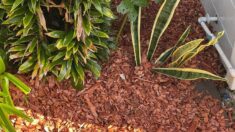
Many homeowners do tree trimming and pruning from late winter through early spring. Tree trimming and pruning are essential for maintaining tree health, safety, and aesthetics. Some do it to improve the tree growth and for other safety and tree-shape purposes. Even some people cut the whole tree and just leave the root in the soil. This tree stump can either regrow or be creatively repurposed in gardens for various uses like planters, furniture, or decorative features.
What Is Tree Stump Grinding?
Tree stump grinding is a method of removing the visible parts of a tree stump by using a powerful grinding machine that grinds them into small wood chips or mulch. The grinder has a rotating cutting disc that chips away the wood. It does not pull the entire tree root system out, but instead grinds the stump down to several inches below ground level.
How Long Does Stump Grinding Take?
However, the time of stump grinding depends on several factors:
1. Size of the Stump
- Small stumps (under 12 inches in diameter): 15–30 minutes
- Medium stumps (12–24 inches): 30–60 minutes
- Large stumps (24+ inches): 1–2 hours or more
2. Tree Type
Hardwood trees like oak, maple, hickory, and walnut take longer to grind than softwoods like pine, cedar, spruce, and fir because the wood is denser and tougher.
3. Root Complexity
Some trees have shallow, simple root systems. Others have extensive, deep roots that slow down the grinding process, especially if roots are partially above ground.
4. Site Accessibility
Stumps in tight corners or hilly terrain may take longer due to equipment access and maneuvering challenges.
5. Depth of Grinding
Standard grinding goes 4–6 inches below the ground. If you want deeper grinding (for replanting or hardscaping), it will take more time.
Stump grinding can take anywhere from 15 minutes to several hours, depending on stump size, age, wood quality, hardness, and depth.
What Happens to Tree Roots After Stump Grinding?
Many people complain that stump grinding also kills the roots, but that’s only partially true.
1. Roots Are Not Fully Removed
Stump grinding removes the stump, not the full root system. It gives a shape to the stump or narrows the broad stump area. The roots remain underground and can spread several feet in every direction. Stump grinding is the way to remove the visible part of a tree, not the root.
2. Do Tree Roots Die After Stump Grinding?
Yes, while the roots remain underground, they lose their source of nutrients and energy. Without the tree stump to support new growth, the remaining roots naturally decay over time. This can take several months to a few years, depending on the tree type and root system. However, if you just give a shape with a stump with the grinding method and don’t go deep, the tree can sometimes sprout new growth.
3. Can New Shoots Grow?
Sometimes, especially with aggressive species like willow, maple, or elm, new shoots may sprout from the remaining roots. These are usually weak and can be controlled with repeated mowing or herbicide if necessary.
Do You Need to Remove Roots Too?
It depends on you whether you want to use the place for another purpose or want to leave it as it is. In most residential situations, tree stump grinding is sufficient. Full root removal is invasive, expensive, and usually unnecessary. You can remove the roots in the following situation.
- You are installing a foundation, driveway, or pool.
- You are planting a new tree in the exact same spot.
- You are dealing with aggressive roots damaging underground utilities or structures.
What Happens After Stump Grinding?
After stump grinding, the remaining roots continue to decay naturally. If the tree doesn’t sprout again and some years pass, the stump starts to decompose in the soil. But trees might also sprout new growth if not properly managed. After grinding, the stump is left with a pile of wood chips and soil mixture. This can be raked away and used as mulch and left to settle, and covered with soil for reseeding or landscaping.
However, most people opt for stump grinding to prevent regrowth, improve aesthetics, enhance yard safety, promote healthy plant growth, free up space, and improve garden decoration.


